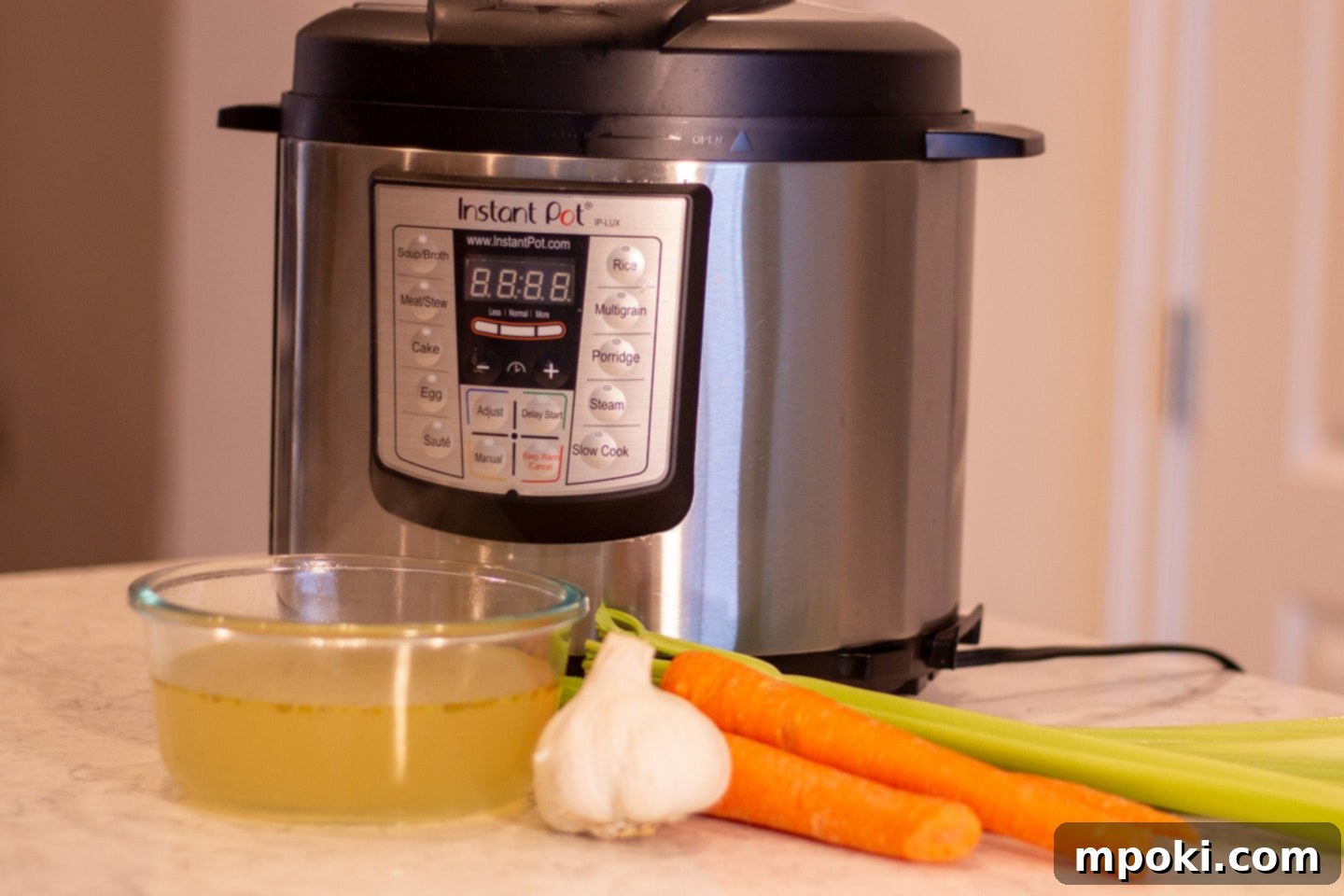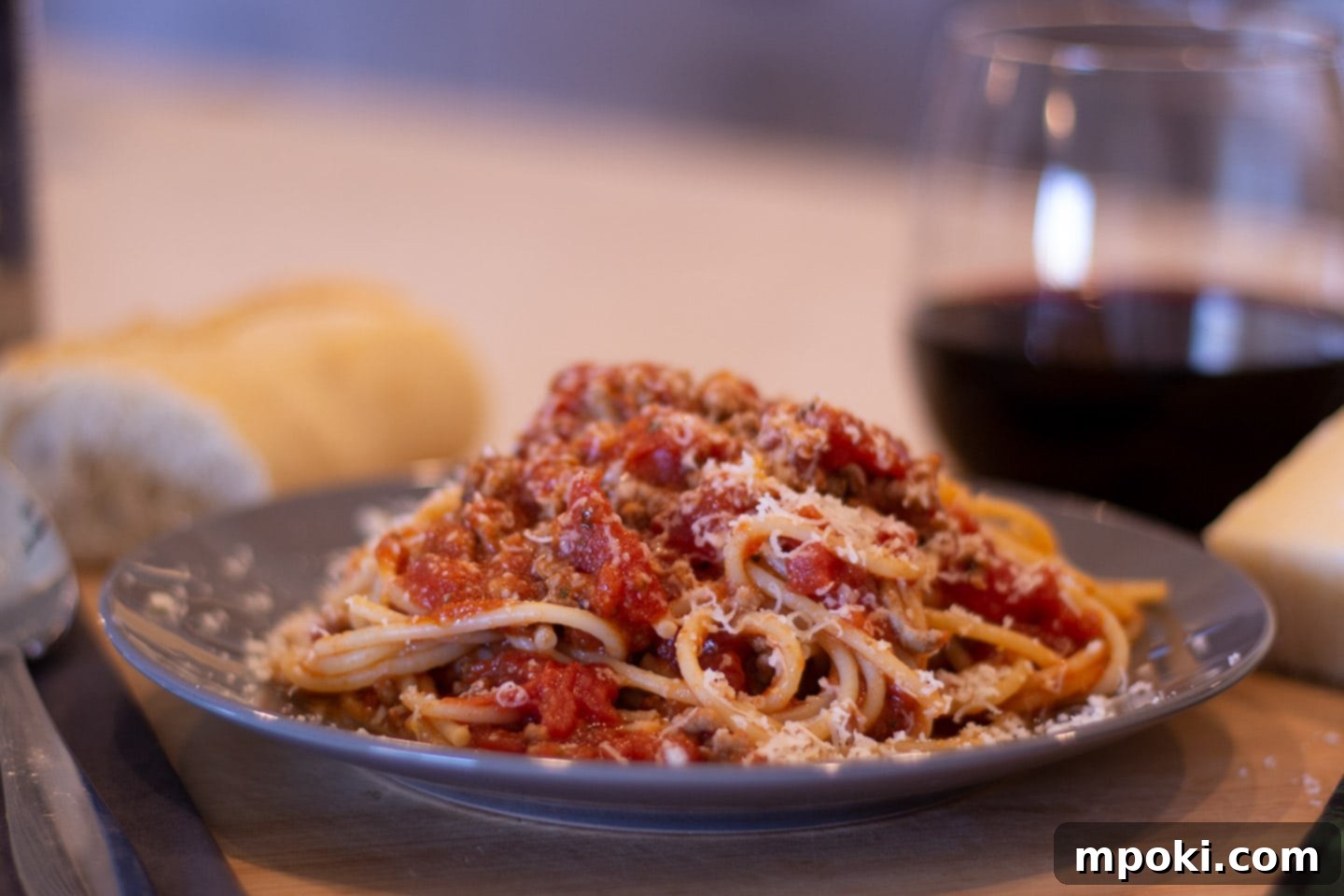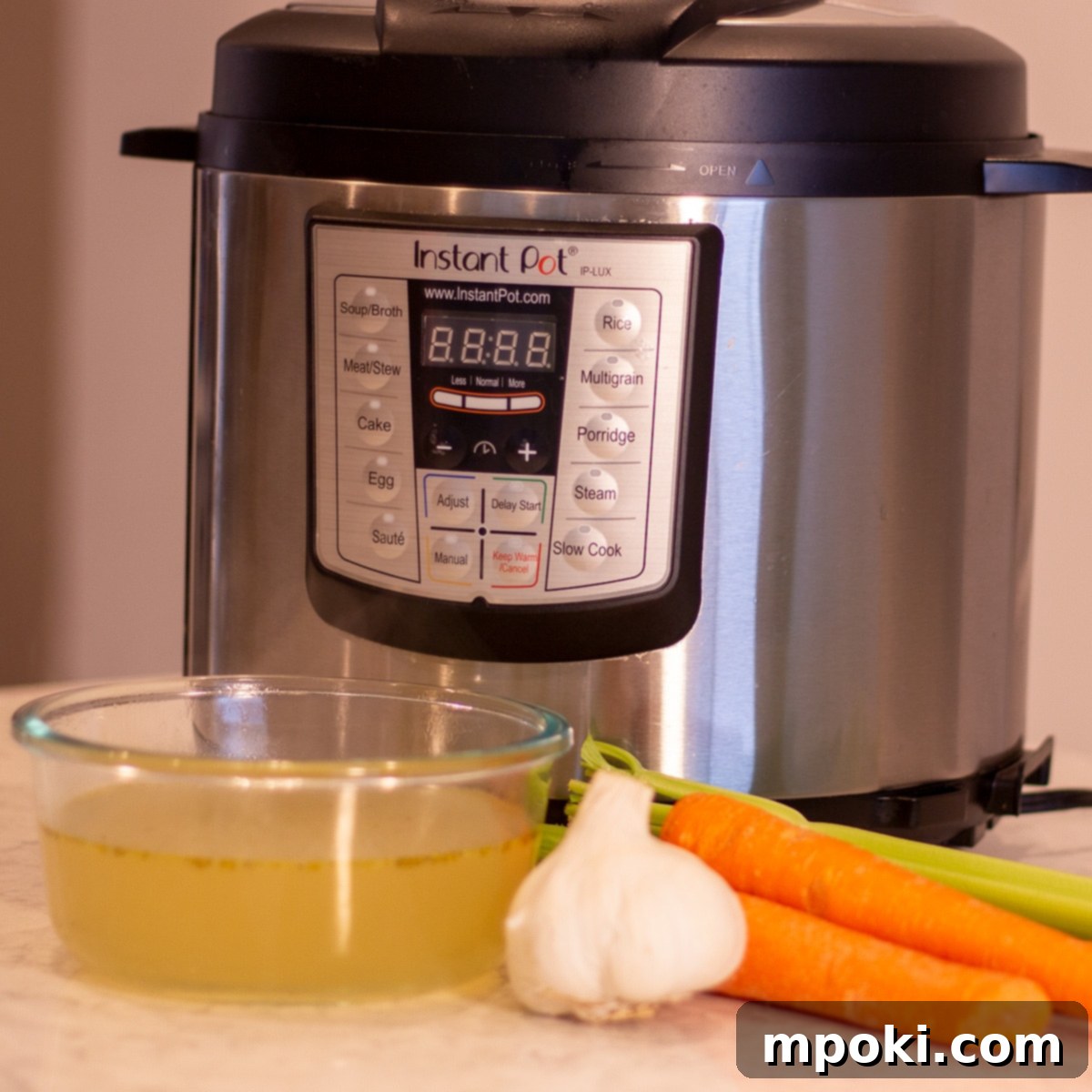
There’s a special kind of satisfaction that comes from transforming forgotten scraps into something truly delicious. Our Instant Pot Chicken Broth recipe does exactly that, taking ingredients you might typically discard and turning them into a rich, flavorful, and incredibly versatile homemade broth. This isn’t just about cooking; it’s about smart, sustainable living, saving money, and infusing your meals with an unparalleled depth of flavor.
Making your own chicken broth in an Instant Pot is a game-changer for any home cook. It’s surprisingly simple, remarkably efficient, and yields a product far superior to anything you can buy in a carton. Imagine soups, stews, risottos, and gravies enhanced by a broth that carries the essence of real chicken and fresh vegetables, all thanks to a bit of kitchen ingenuity and the power of pressure cooking.
This Page Contains Affiliate Links. For more Info See My Disclosures here.
Unlock Flavor & Save Money with Homemade Instant Pot Chicken Broth
In today’s world, where both budget-consciousness and environmental awareness are increasingly important, learning to make the most of every ingredient is a valuable skill. This Instant Pot Chicken Broth recipe epitomizes that philosophy. Instead of tossing out vegetable ends, herb stems, and chicken bones, you can harness their hidden potential to create a foundational ingredient for countless dishes. This isn’t just about being frugal; it’s about crafting a healthier, more flavorful product free from excessive sodium or artificial additives often found in store-bought options.
The Instant Pot streamlines what used to be an all-day affair on the stovetop into a fast, hands-off process. Pressure cooking extracts maximum flavor and nutrients from your ingredients in a fraction of the time, resulting in a rich, gelatinous broth that’s packed with goodness. Whether you’re a seasoned chef or just starting your culinary journey, this recipe offers an accessible way to elevate your cooking and embrace a more sustainable kitchen.
The Art of Zero-Waste Cooking: Saving Your Scraps
One of the core principles behind this incredible broth is the utilization of vegetable scraps. Every time you chop an onion, peel a carrot, or trim celery, you’re left with valuable bits that often go straight into the trash or compost. But these “scraps” are far from useless. They are packed with flavor compounds that, when simmered slowly (or quickly, in the case of an Instant Pot), contribute significantly to the complexity and aroma of your broth.
Think of it as building blocks for flavor. The outer layers of onions, the leafy tops of carrots, the ends of celery stalks – these might not be appealing to eat on their own, but they are flavor powerhouses. By collecting these, you not only reduce food waste but also imbue your broth with a depth that would otherwise be missing. It’s a simple habit that pays dividends in taste and sustainability.
Which Vegetable Scraps Work Best?
Not all scraps are created equal for broth-making. Here’s a list of common kitchen discards that will contribute wonderfully to your chicken broth:
- Onion Ends and Peels: These add a deep, savory sweetness and a lovely golden hue to your broth.
- Carrot Tops and Ends: Sweet, earthy notes are drawn from these often-discarded pieces.
- Celery Leaves and Bases: Essential for that classic aromatic base, celery scraps provide a subtle freshness.
- Garlic Skins and Ends: Aromatic and pungent, they contribute to the savory profile without being overpowering.
- Mushroom Stems: These add a rich umami depth that elevates the entire broth.
- Leek Greens: Similar to onions, leek greens offer a milder, sweeter allium flavor. Ensure they are thoroughly washed to remove any grit.
- Herb Stems (Parsley, Thyme, Rosemary): Don’t throw away those herb stems! They are bursting with essential oils that will perfume your broth beautifully.
- Bell Pepper Cores (Use Sparingly): While they can add a faint sweetness, too many bell pepper cores can make your broth bitter, so use them in moderation if at all.
To store your scraps, simply keep a large freezer-safe bag or container in your freezer. As you prep meals throughout the week, toss in your suitable vegetable scraps. When the bag is full, you know it’s time to make another batch of delicious, homemade broth!
Maximizing Your Rotisserie Chicken: Don’t Discard the Carcass!
Rotisserie chickens from stores like Sam’s Club or Costco are a true culinary marvel. They are incredibly convenient, budget-friendly, and undeniably delicious, often costing less than an uncooked chicken. They are a go-to for many busy individuals and families, including Dad, when there’s little time or energy for extensive cooking.
Once you’ve enjoyed the succulent meat from your rotisserie chicken, resist the urge to discard the bones. That carcass is a treasure trove of flavor and collagen, perfect for making an outstanding broth. The roasting process already performed on the rotisserie chicken means its bones and any remaining meat have already been caramelized, contributing a deeply savory foundation to your broth without any extra effort on your part.
After carving your chicken, simply place the entire carcass, along with any skin or small bits of meat that remain, into a freezer bag. Store it in the freezer until you’re ready to make broth. Collecting a few carcasses over time can lead to an even richer, more abundant batch of stock.
Starting Fresh: Using Whole Chickens for Superior Broth
While rotisserie chicken carcasses are excellent for broth, using fresh chicken parts offers another level of control and flavor. Many home cooks, like Dad, prefer to buy whole chickens and break them down themselves. This approach often provides better value and yields a variety of parts perfect for broth, such as the carcass, backbone, wing tips, and even gizzards.
These fresh components are ideal for creating a truly extraordinary chicken broth in your Instant Pot. The key step for fresh chicken is to roast these parts before adding them to the pressure cooker. This process, often overlooked, is crucial for developing a profound depth of flavor and a beautiful golden color in your finished broth. It’s an extra step that makes a world of difference.
To prepare your fresh chicken parts for roasting, simply coat them lightly in a couple of tablespoons of olive oil. Then, season them generously with a blend of garlic powder, onion powder, sea salt, cracked black pepper, dried basil, and dried oregano. These seasonings will infuse the chicken as it roasts, contributing a more complex flavor profile to your broth. Roast them in a 450°F (230°C) oven for 20 to 25 minutes, or until they achieve a rich, golden-brown hue, before they make their way into the Instant Pot.
Why Roast Your Chicken Parts First?
Roasting chicken bones and scraps before making broth isn’t just about color; it’s about flavor development. This process initiates the Maillard reaction, a chemical reaction between amino acids and reducing sugars that gives browned food its distinctive flavor. When you roast the chicken, you’re essentially caramelizing the proteins and fats, creating hundreds of new flavor compounds that will dissolve into your broth, making it incredibly rich, savory, and aromatic. This step transforms a good broth into an exceptional one, adding layers of savory depth that can’t be achieved by simply boiling unroasted bones.
The Magic of the Instant Pot: Speed and Efficiency
The Instant Pot, or any electric pressure cooker, is truly the star of this recipe. Traditionally, making chicken broth involved hours of simmering on the stovetop, constantly monitoring the pot and topping up water. While that method certainly produces delicious results, it’s not always practical for busy schedules.
The Instant Pot dramatically cuts down cooking time while maximizing flavor extraction. Under pressure, temperatures rise above the boiling point, forcing flavors and collagen from the bones and vegetables into the liquid much more rapidly. This means you can achieve a broth that tastes like it simmered all day in just 30-90 minutes of active cooking time. The sealed environment also prevents evaporation, concentrating flavors and nutrients beautifully.
This efficiency makes homemade broth an accessible reality for even the busiest cooks. You can set it and forget it, returning to a perfectly prepared, deeply nourishing broth ready to elevate your culinary creations. It’s a testament to how modern kitchen appliances can simplify traditional cooking techniques without compromising on quality.

Instant Pot Chicken Broth Recipe
Don’t throw away your vegetable or chicken scraps! You can use them to make a healthy and delicious chicken broth for basically FREE!
Course: Soup | Cuisine: American | Keyword: easy recipes, Instant Pot, homemade broth, zero-waste cooking
Prep Time: 5 minutes | Cook Time: 55 minutes | Servings: 10 | Calories: 58 kcal | Author: Dad
Print Recipe
Pin Recipe
Equipment
- Instant Pot or Electric Pressure Cooker
- Fine mesh colander or sieve
- Large heat-proof bowl or container
Ingredients
- 1 Chicken carcass (from a whole roasted chicken or rotisserie chicken)
- 2 cups Vegetable scraps (onion ends, carrot peels, celery leaves, garlic skins, herb stems, mushroom stems, leek greens, etc.)
- 1 tablespoon Garlic powder (if roasting fresh chicken parts)
- 1 tablespoon Onion powder (if roasting fresh chicken parts)
- 1 tablespoon Dried basil
- 1 tablespoon Dried oregano
- 1 tablespoon Sea salt (or to taste, adjust as needed)
- 1 tablespoon Cracked black pepper (if roasting fresh chicken parts)
- 1 tablespoon Minced garlic (for the pot)
- 2 tablespoons Olive oil (if roasting fresh chicken parts)
- Water (to PCMAX line)
Instructions
- If you are using fresh chicken parts (such as a carcass from a whole chicken you’ve butchered, backbone, or wings), first coat them lightly in 2 tablespoons of olive oil. Then, season them generously with 1 tablespoon each of garlic powder, onion powder, sea salt, cracked black pepper, dried basil, and dried oregano. If you are using a carcass from a pre-cooked rotisserie chicken, you can skip the roasting step and proceed directly to step 3.
- (Optional, but highly recommended for fresh chicken parts) Roast the seasoned fresh chicken parts in a 450°F (230°C) oven for 20-25 minutes. This step is crucial for developing a rich, deep flavor and a beautiful color in your broth through the Maillard reaction. You want to see some nice browning on the chicken pieces.
- Carefully place all your collected vegetable scraps (whether fresh from prepping a meal or frozen from your scrap collection) into the inner pot of your Instant Pot. Add the chicken carcass (roasted or rotisserie) on top of the vegetables.
- Fill the Instant Pot with fresh, cold water until it reaches the “PCMAX” (Pressure Cook Maximum) line indicated on the inner pot. Ensure all ingredients are adequately submerged.
- Add 1 tablespoon of minced garlic directly into the pot. Include an additional teaspoon of dried basil and a teaspoon of dried oregano for an extra aromatic boost.
- Season the contents with 1 tablespoon of sea salt. Remember that you can always adjust the saltiness later, so it’s better to start with a moderate amount.
- Give everything a gentle stir to combine the ingredients. Secure the lid on your Instant Pot, making sure the sealing vent is set to the “Sealing” position.
- Cook on the “Soup/Broth” preset or “Manual” (Pressure Cook) setting on High pressure for 30-90 minutes. A 30-minute cook time will produce a lighter, clearer broth with a less intense flavor. Cooking for 60-90 minutes will result in a much richer, more concentrated, and gelatinous broth with maximum flavor extraction.
- Once the cooking cycle is complete, you have two options for pressure release: You can allow a natural pressure release (NPR) for at least 10-15 minutes, which helps to further tenderize ingredients and prevents frothing. Alternatively, you can perform a quick release (QR) by carefully turning the sealing vent to “Venting” (be mindful of the hot steam).
- After the pressure has fully released and the float valve has dropped, carefully open the Instant Pot lid. Using a fine-mesh colander or sieve, strain the broth into a large, heat-proof bowl or container, discarding all the cooked solids. You are now left with a wonderful, incredibly flavorful, and essentially free chicken broth, ready to be used or stored!
Video
Nutrition Information (per serving)
Calories: 58kcal | Carbohydrates: 7g | Protein: 2g | Fat: 3g | Saturated Fat: 1g | Sodium: 716mg | Potassium: 115mg | Fiber: 2g | Sugar: 1g | Vitamin A: 1857IU | Vitamin C: 4mg | Calcium: 29mg | Iron: 1mg
Tried this recipe? Mention @DadGotThis or tag #DadGotThis!
Tips for Perfect Instant Pot Chicken Broth Every Time
Making excellent chicken broth is simple, but a few key tips can elevate your results and ensure you get the most out of your efforts:
- Degreasing the Broth: After straining, let your broth cool. As it cools, any fat will rise to the top and solidify. Once completely chilled (ideally in the refrigerator overnight), you can easily skim off the solidified fat. This makes for a clearer, lighter broth. A thin layer of fat can be left for flavor, but removing most of it is often preferred.
- Cooling and Storage Solutions: Never put hot broth directly into the refrigerator, as it can raise the internal temperature of your fridge to unsafe levels. Allow the broth to cool to room temperature first, then transfer it to airtight containers. For short-term storage, it will keep in the refrigerator for up to 4-5 days. For longer storage, homemade broth freezes beautifully! Pour it into freezer-safe containers, leaving some headspace for expansion, or into ice cube trays for convenient single-serving portions. Frozen broth can last for 3-6 months.
- Customizing Your Broth: This recipe is a fantastic base, but don’t hesitate to experiment! You can add other aromatics like ginger slices, bay leaves, or a pinch of peppercorns. For a spicier kick, a few dried chilies can be included. Consider adding a splash of apple cider vinegar at the beginning; it’s believed to help extract more minerals from the bones.
- Salt to Taste, Not to Cook: While the recipe calls for a tablespoon of salt, always remember that you can add more later but can’t take it away. If you plan to reduce your broth significantly for a sauce, or if you’re adding it to an already salty dish, start with less salt.
Beyond the Broth: How to Use Your Homemade Stock
Once you have a batch of this golden elixir, the culinary possibilities are endless. Homemade chicken broth is a fundamental building block for countless delicious meals. Here are just a few ideas to get you started:
- Soups and Stews: This is the most obvious use! From classic chicken noodle soup to hearty vegetable stews, your broth will be the flavorful foundation.
- Risottos and Grains: Use it instead of water when cooking rice, quinoa, or couscous for an added layer of savory goodness. It’s essential for a truly authentic and creamy risotto.
- Sauces and Gravies: Reduce the broth to create rich pan sauces or gravies that will elevate any roasted meat or mashed potatoes.
- Braising Meats: Perfect for braising chicken thighs, short ribs, or pot roasts, ensuring tender, flavorful results.
- Deglazing Pans: After searing meats or vegetables, a splash of broth can deglaze the pan, capturing all those flavorful browned bits.
- Steaming Vegetables: Use broth instead of water for steaming vegetables to infuse them with extra flavor.
The Health Benefits of Homemade Chicken Broth
Beyond its incredible taste and economic advantages, homemade chicken broth offers a range of potential health benefits, making it a truly nourishing addition to your diet:
- Rich in Collagen: The slow cooking (or pressure cooking) of bones extracts collagen, which breaks down into gelatin. This is beneficial for joint health, skin elasticity, and gut lining.
- Packed with Minerals: Bones contain essential minerals like calcium, magnesium, phosphorus, and potassium, which are released into the broth.
- Amino Acids: Broth contains various amino acids, including glycine and proline, which play roles in detoxification, metabolism, and immune function.
- Immune Support: Often considered a traditional remedy for colds and flu, chicken broth can be soothing and hydrating, and its nutrient content may support immune health.
- Gut Health: The gelatin in broth can help support a healthy gut lining, which is crucial for overall digestive health.
- Hydration: A warm cup of broth is excellent for hydration, especially when you’re feeling under the weather.
By making your own Instant Pot chicken broth, you’re not just creating a culinary staple; you’re investing in your health and contributing to a more sustainable kitchen.
Looking for Another Easy Recipe?

Once you’ve mastered this amazing chicken broth and experienced the joy of homemade goodness, why not try out Dad’s Easy Meat Sauce? It’s another family favorite that’s simple to make, incredibly satisfying, and pairs perfectly with a generous splash of your freshly made chicken broth for added depth!
Connect with Dad on YouTube!
For more fantastic cooking videos, practical kitchen hacks, and delicious food-related content that makes cooking fun and accessible, make sure to visit and subscribe to Dad’s YouTube channel. You’ll find a wealth of inspiration to bring more homemade goodness to your table!
